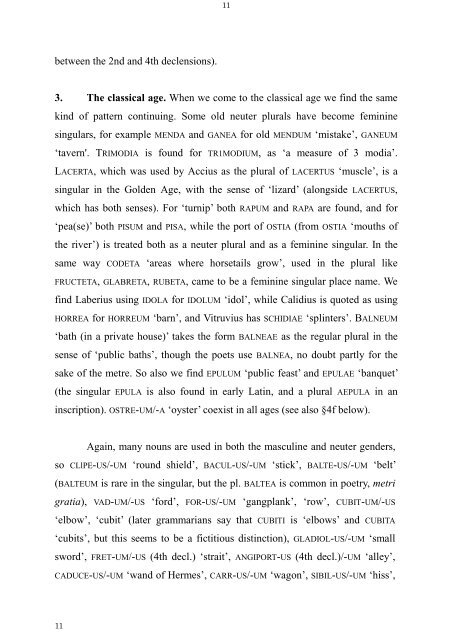The Latin Neuter Plurals in Romance - Page ON
The Latin Neuter Plurals in Romance - Page ON
The Latin Neuter Plurals in Romance - Page ON
Create successful ePaper yourself
Turn your PDF publications into a flip-book with our unique Google optimized e-Paper software.
etween the 2nd and 4th declensions).<br />
11<br />
11<br />
3. <strong>The</strong> classical age. When we come to the classical age we f<strong>in</strong>d the same<br />
k<strong>in</strong>d of pattern cont<strong>in</strong>u<strong>in</strong>g. Some old neuter plurals have become fem<strong>in</strong><strong>in</strong>e<br />
s<strong>in</strong>gulars, for example MENDA and GANEA for old MENDUM ‘mistake’, GANEUM<br />
‘tavern'. TRIMODIA is found for TR1MODIUM, as ‘a measure of 3 modia’.<br />
LACERTA, which was used by Accius as the plural of LACERTUS ‘muscle’, is a<br />
s<strong>in</strong>gular <strong>in</strong> the Golden Age, with the sense of ‘lizard’ (alongside LACERTUS,<br />
which has both senses). For ‘turnip’ both RAPUM and RAPA are found, and for<br />
‘pea(se)’ both PISUM and PISA, while the port of OSTIA (from OSTIA ‘mouths of<br />
the river’) is treated both as a neuter plural and as a fem<strong>in</strong><strong>in</strong>e s<strong>in</strong>gular. In the<br />
same way CODETA ‘areas where horsetails grow’, used <strong>in</strong> the plural like<br />
FRUCTETA, GLABRETA, RUBETA, came to be a fem<strong>in</strong><strong>in</strong>e s<strong>in</strong>gular place name. We<br />
f<strong>in</strong>d Laberius us<strong>in</strong>g IDOLA for IDOLUM ‘idol’, while Calidius is quoted as us<strong>in</strong>g<br />
HORREA for HORREUM ‘barn’, and Vitruvius has SCHIDIAE ‘spl<strong>in</strong>ters’. BALNEUM<br />
‘bath (<strong>in</strong> a private house)’ takes the form BALNEAE as the regular plural <strong>in</strong> the<br />
sense of ‘public baths’, though the poets use BALNEA, no doubt partly for the<br />
sake of the metre. So also we f<strong>in</strong>d EPULUM ‘public feast’ and EPULAE ‘banquet’<br />
(the s<strong>in</strong>gular EPULA is also found <strong>in</strong> early <strong>Lat<strong>in</strong></strong>, and a plural AEPULA <strong>in</strong> an<br />
<strong>in</strong>scription). OSTRE-UM/-A ‘oyster’ coexist <strong>in</strong> all ages (see also §4f below).<br />
Aga<strong>in</strong>, many nouns are used <strong>in</strong> both the mascul<strong>in</strong>e and neuter genders,<br />
so CLlPE-US/-UM ‘round shield’, BACUL-US/-UM ‘stick’, BALTE-US/-UM ‘belt’<br />
(BALTEUM is rare <strong>in</strong> the s<strong>in</strong>gular, but the pl. BALTEA is common <strong>in</strong> poetry, metri<br />
gratia), VAD-UM/-US ‘ford’, FOR-US/-UM ‘gangplank’, ‘row’, CUBIT-UM/-US<br />
‘elbow’, ‘cubit’ (later grammarians say that CUBITI is ‘elbows’ and CUBITA<br />
‘cubits’, but this seems to be a fictitious dist<strong>in</strong>ction), GLADIOL-US/-UM ‘small<br />
sword’, FRET-UM/-US (4th decl.) ‘strait’, ANGIPORT-US (4th decl.)/-UM ‘alley’,<br />
CADUCE-US/-UM ‘wand of Hermes’, CARR-US/-UM ‘wagon’, SIBIL-US/-UM ‘hiss’,









